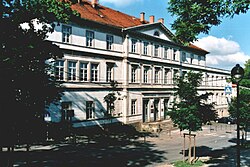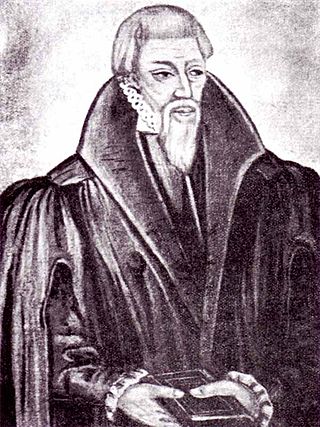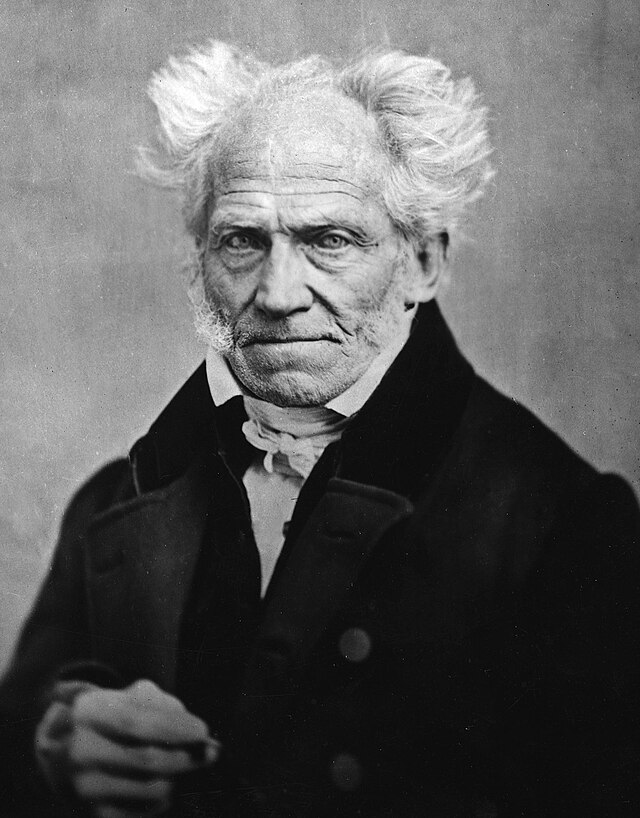Loading AI tools
Secondary school in Germany From Wikipedia, the free encyclopedia
The Ernestine Gymnasium (Latin name: Ernestinum, used in German) is a humanistic and modern gymnasium in Gotha, Germany, the successor of the Illustrious Gymnasium (Gymnasium illustre), founded in 1524, which in 1853 was merged with the recently founded Real-Gymnasium Ernestinum, named in honour of Ernest I, Duke of Saxe-Coburg and Gotha. The merged school continued to be known as the Ernestinum. Until 1947, when it was closed, it was considered the oldest gymnasium in the German-speaking world. It was re-founded in 1991, shortly after German reunification.
| Ernestinum Ernestine Gymnasium | |
|---|---|
 | |
| Location | |
 | |
Bergallee 8 99867 Gotha Germany | |
| Coordinates | 50°56′44″N 10°42′02″E |
| Information | |
| Former names | Gymnasium Gothanum (1524–1600) Illustrious Gymnasium (1600–1853) |
| Motto | Cum Deo et die (With God and in the day) |
| Established | 1524, re-named c. 1600, merged with Ducal Gymnasium and renamed again, 1853, closed 1947, refounded 1991 |
| Founder | Friedrich Myconius |
| Closed | 1947–1991 |
| Principal | Dr. Lutz Wagner |
| Gender | coeducational (since 1991) |
| Website | ernestinum-gotha |
The school's earliest forerunner was a Latin school at the parish church of St Mary, which is mentioned in 1291.[1]

On 21 December 1524, the school was founded by Friedrich Myconius, a friend of Martin Luther, in the cloister of the Augustinian monastery of Gotha, which was in the process of being dissolved,[1] and was given the Latin name Gymnasium Gothanum.[2] As a result of the Reformation, in the middle of the 16th century the curriculum was changed significantly, under the direction of Cyriacus Lindemann (1562–1568). His focus was grammar, the understanding of Roman authors, and careful written work by the students, and he also introduced declamation.[3][4]
Around 1600, the school's name was honoured by the addition of "illustrious" by Duke John Casimir of Saxe-Coburg. Under the rector Andreas Wilke (1592–1631) the number of schoolmasters and classes increased.[5]
In the 17th century, the school was further sponsored by Duke Ernest I of Saxe-Gotha-Altenburg. He gave asylum to sons of persecuted Lutherans from Hungary, Silesia, Poland, Russia, and Scandinavia, who joined the school. Under the rector Andreas Reyher (1641–1673), the Gotha school system was reformed on the principles of Wolfgang Ratke, and the school became known internationally. The number of subjects increased, with the introduction of Mathematics, poetry, and history, and for the first time there was teaching in German. Rhetoric, logic, ethics, and metaphysics, were taught in the Selecta, or final year.[6][4] By 1723, the school was already known as the Gymnasium Ernestinum.[7]
In the 18th century, the Enlightenment reshaped education in much of northern Europe, and the school received great support from Duke Ernest II of Saxe-Gotha-Altenburg, guided by the principle that good education in all subjects was essential for the economic and political stability of the Duchy. Under Johann Gottfried Geißler as rector (1768–1779), the time given to ancient languages was reduced in favour of the natural sciences and German, English, and French literature.[6][4]
The school enjoyed notable rectors, including Friedrich Andreas Stroth (1779–1785), and Friedrich Wilhelm Döring (1786–1833), and also renowned schoolmasters such as Johann Georg August Galletti, Johann Friedrich Salomon Kaltwasser, Adolf Heinrich Friedrich von Schlichtegroll, Johann Kaspar Friedrich Manso, and Friedrich Jacobs.[6][4]
In 1807, the future philosopher Arthur Schopenhauer was admitted to the school[8] and in 1808 was expelled for a prank.[9]

Between 1837 and 1838, a new school building was built in the classical style in the Bergallee. However, the school was challenged by a new competitor, founded in 1836 by the reigning Duke for the benefit of the bourgeoisie, the Real-gymnasium Ernestinum, which had a chiefly scientific and mathematical curriculum. At the older school, chemistry, physics, and geology began to be taught as separate subjects, and the modern languages French and English overtook Latin in importance.[6]
On 12 April 1859, the Illustrious Gymnasium and the Ducal Realgymnasium were merged into a single school, which was named Gymnasium Ernestinum Gothae in honour of Duke Ernest I of Saxe-Coburg-Gotha.[4]
The new school was given a new rector, Joachim Marquardt, (1859–1882), notable for securing discipline without harsh punishments. The school grew, gaining an auditorium, new library rooms, and a gymnasium.

Following Marquardt's death in 1882, the school commissioned a medallion to commemorate him, made by the local engraver Ferdinand Helfricht.[10]
Heinrich Anz (1914–1935) continued to lead a humanistic grammar school under the Weimar Republic.[11] A new rector, Otto Küttler (1938–1945), took the school through the Second World War, when it suffered from masters and boys departing on military service. During the war the school library was evacuated to Friedenstein Palace.[4] The school was by then considered the oldest grammar school in the German-speaking world.[6]
After the war, the school found itself in the Soviet occupation zone. With the introduction of a new educational system, a humanistic grammar school was no longer required. The last Abitur exams were held in the 1945/46 school year, and in the spring of 1947, the school was closed.[12] On 10 April 1947, the boys were transferred to a school called the Arnoldischule. The former school buildings were taken over by a new middle school, and then in 1959 by a polytechnic high school, which in 1965 was named POS Albert Schweitzer.[6]
On 1 November 1991, following German reunification, the Ernestine Gymnasium was re-established,[12] with Lutz Wagner as Schulleiter, or Principal, and in 1993 the first Abitur examinations took place, after a gap of 48 years. Until 1947, the school had been for boys only, but it was decided to make the newly refounded school coeducational.[2]











Seamless Wikipedia browsing. On steroids.
Every time you click a link to Wikipedia, Wiktionary or Wikiquote in your browser's search results, it will show the modern Wikiwand interface.
Wikiwand extension is a five stars, simple, with minimum permission required to keep your browsing private, safe and transparent.